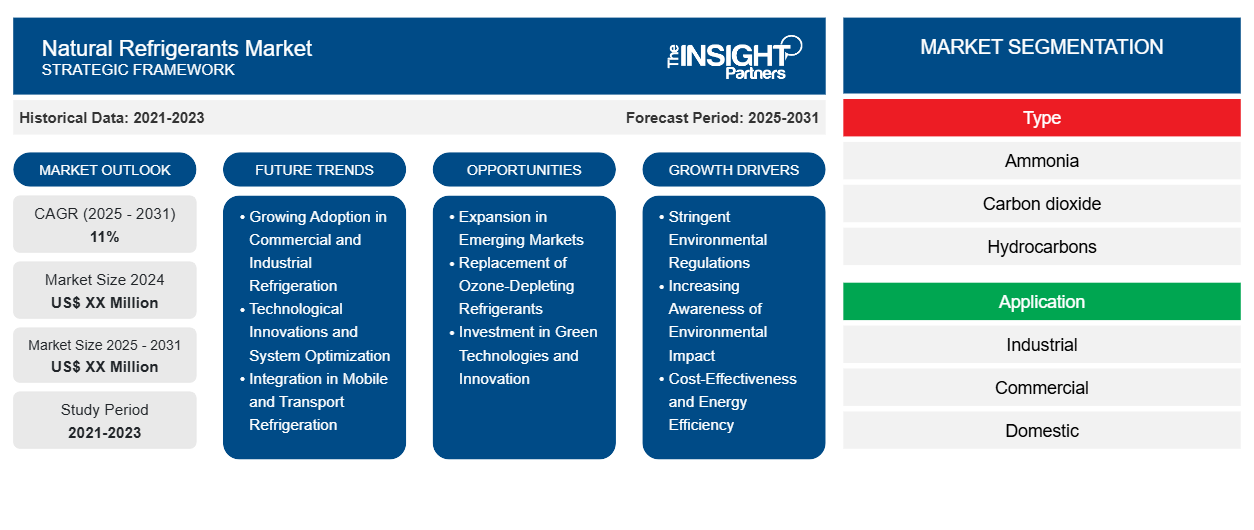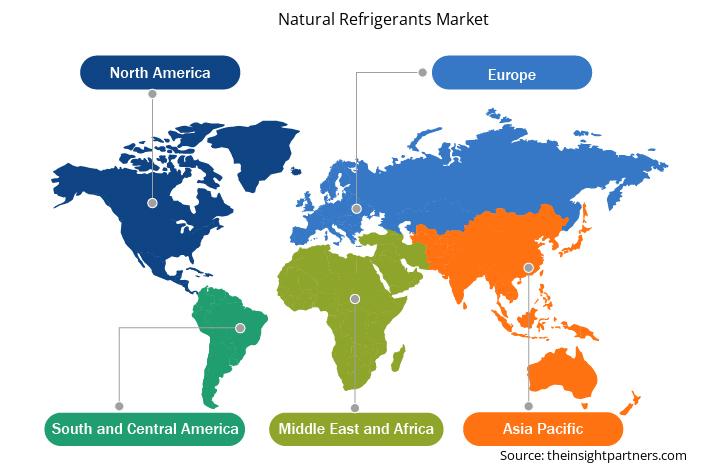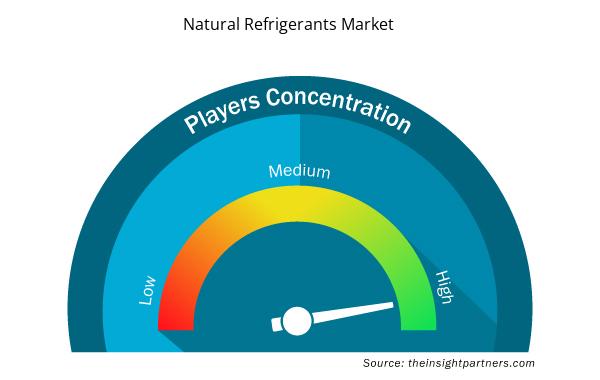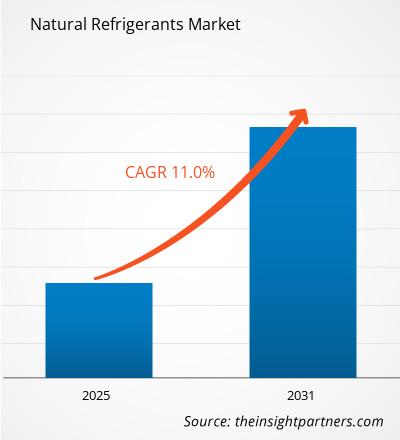The Natural Refrigerants Market is expected to register a CAGR of 11% from 2025 to 2031, with a market size expanding from US$ XX Million in 2024 to US$ XX Million by 2031.
The natural refrigerants market report is segmented by type (ammonia, carbon dioxide, hydrocarbons, and others). The market is segmented based on application (industrial, commercial, domestic, air conditioning, and others). The market size and forecast at global, regional, and country levels for all the key market segments are covered under the scope. The report offers the value in USD for the above analysis, segments, regions, and countries. The report covers market trends, as well as market dynamics such as drivers, restraints, and key opportunities. The report also covers industry landscape and competition analysis covering market concentration, heat map analysis, prominent players, and recent developments in the market.
Purpose of the Report
The report Natural Refrigerants Market by The Insight Partners aims to describe the present landscape and future growth, top driving factors, challenges, and opportunities. This will provide insights to various business stakeholders, such as:
- Technology Providers/Manufacturers: To understand the evolving market dynamics and know the potential growth opportunities, enabling them to make informed strategic decisions.
- Investors: To conduct a comprehensive trend analysis regarding the market growth rate, market financial projections, and opportunities that exist across the value chain.
- Regulatory bodies: To regulate policies and police activities in the market with the aim of minimizing abuse, preserving investor trust and confidence, and upholding the integrity and stability of the market.
Natural Refrigerants Market Segmentation
Type
- Ammonia
- Carbon dioxide
- Hydrocarbons
Application
- Industrial
- Commercial
- Domestic
- Air Conditioning
Customize This Report To Suit Your Requirement
You will get customization on any report - free of charge - including parts of this report, or country-level analysis, Excel Data pack, as well as avail great offers and discounts for start-ups & universities
Natural Refrigerants Market: Strategic Insights

- Get Top Key Market Trends of this report.This FREE sample will include data analysis, ranging from market trends to estimates and forecasts.
Natural Refrigerants Market Growth Drivers
- Stringent Environmental Regulations: The global push for sustainability, especially through international agreements like the Paris Agreement and the Kigali Amendment to the Montreal Protocol, is one of the primary drivers of the natural refrigerants market. Governments worldwide are enforcing stricter regulations to phase out hydrofluorocarbons (HFCs), which are potent greenhouse gases. In response, businesses and industries are adopting natural refrigerants such as CO2, ammonia, and hydrocarbons to comply with environmental standards and reduce their carbon footprint.
- Increasing Awareness of Environmental Impact: Consumers and industries are becoming more environmentally conscious, driving the demand for green alternatives across various sectors. Natural refrigerants have a significantly lower global warming potential (GWP) compared to synthetic refrigerants like HFCs, making them a more sustainable choice. As environmental awareness grows, particularly in sectors like food and beverage, retail, and commercial refrigeration, companies are increasingly turning to natural refrigerants to meet consumer expectations and minimize environmental harm.
- Cost-Effectiveness and Energy Efficiency: Natural refrigerants are often more energy-efficient than synthetic alternatives, leading to lower operational costs over time. For instance, CO2 and ammonia-based systems are known to provide higher efficiency in large-scale refrigeration systems, resulting in reduced energy consumption and lower long-term maintenance costs. As energy prices rise globally, industries are increasingly opting for natural refrigerants to cut operating expenses and achieve better performance while adhering to environmental standards.
Natural Refrigerants Market Future Trends
- Growing Adoption in Commercial and Industrial Refrigeration: The commercial and industrial refrigeration sectors are increasingly adopting natural refrigerants due to their superior energy efficiency, environmental benefits, and regulatory compliance. Supermarkets, cold storage facilities, and warehouses are among the main adopters of natural refrigerants like CO2 and ammonia. This trend is expected to continue as companies seek cost-effective and sustainable refrigeration systems, especially in the food and beverage sector, which is highly regulated.
- Technological Innovations and System Optimization: Technological advancements will play a crucial role in the growth of the natural refrigerants market. Ongoing research and development efforts are focused on improving the performance of natural refrigerant-based systems, including enhanced compressors, advanced heat exchangers, and leak detection technologies. The development of hybrid systems, where natural refrigerants are combined with synthetic ones, may offer increased efficiency and system reliability. These innovations are expected to make natural refrigerants more viable across different temperature ranges and applications.
- Integration in Mobile and Transport Refrigeration: The integration of natural refrigerants in transport refrigeration systems is gaining momentum. CO2 and hydrocarbons like propane are being increasingly used in vehicle air conditioning and refrigerated transport, such as in trucks and containers for transporting food. As transportation regulations become stricter regarding emissions, and demand for refrigerated goods increases globally, natural refrigerants are expected to dominate this space due to their low environmental impact.
Natural Refrigerants Market Opportunities
- Expansion in Emerging Markets: The growing industrialization and urbanization of emerging markets, particularly in Asia-Pacific, Latin America, and Africa, offer significant opportunities for natural refrigerants. These regions are witnessing rapid growth in the retail, food processing, and construction sectors, creating demand for energy-efficient and sustainable refrigeration solutions. Governments in these markets are also increasingly adopting stricter environmental regulations, creating a favorable environment for the adoption of natural refrigerants.
- Replacement of Ozone-Depleting Refrigerants: As countries continue to phase out ozone-depleting substances (such as CFCs and HCFCs) under global agreements, natural refrigerants provide an excellent alternative. Industries using outdated systems that still rely on ozone-depleting refrigerants have an opportunity to retrofit or replace these systems with natural refrigerants, capitalizing on lower GWP options. This replacement trend is particularly strong in the HVAC (heating, ventilation, and air conditioning) sector, where older systems are being upgraded.
- Investment in Green Technologies and Innovation: The market for natural refrigerants presents significant investment opportunities, particularly in the development of green technologies. Companies and governments are increasingly investing in research and development to improve the efficiency, safety, and application scope of natural refrigerants. For instance, the development of innovative heat pump systems that use CO2 as a refrigerant offers a unique opportunity in the residential and commercial heating market. These technologies could become mainstream as the demand for environmentally responsible solutions grows.
Natural Refrigerants Market Regional Insights
The regional trends and factors influencing the Natural Refrigerants Market throughout the forecast period have been thoroughly explained by the analysts at Insight Partners. This section also discusses Natural Refrigerants Market segments and geography across North America, Europe, Asia Pacific, Middle East and Africa, and South and Central America.

- Get the Regional Specific Data for Natural Refrigerants Market
Natural Refrigerants Market Report Scope
| Report Attribute | Details |
|---|---|
| Market size in 2024 | US$ XX Million |
| Market Size by 2031 | US$ XX Million |
| Global CAGR (2025 - 2031) | 11% |
| Historical Data | 2021-2023 |
| Forecast period | 2025-2031 |
| Segments Covered |
By Type
|
| Regions and Countries Covered | North America
|
| Market leaders and key company profiles |
Natural Refrigerants Market Players Density: Understanding Its Impact on Business Dynamics
The Natural Refrigerants Market market is growing rapidly, driven by increasing end-user demand due to factors such as evolving consumer preferences, technological advancements, and greater awareness of the product's benefits. As demand rises, businesses are expanding their offerings, innovating to meet consumer needs, and capitalizing on emerging trends, which further fuels market growth.
Market players density refers to the distribution of firms or companies operating within a particular market or industry. It indicates how many competitors (market players) are present in a given market space relative to its size or total market value.
Major Companies operating in the Natural Refrigerants Market are:
- Linde Group
- Airgas Inc
- A-Gas International
- Sinochem
- Puyang Zongwei Fine Chemical Co Ltd
- Shangdong Yueon Chemical Co Ltd
Disclaimer: The companies listed above are not ranked in any particular order.

- Get the Natural Refrigerants Market top key players overview
Key Selling Points
- Comprehensive Coverage: The report comprehensively covers the analysis of products, services, types, and end users of the Natural Refrigerants Market, providing a holistic landscape.
- Expert Analysis: The report is compiled based on the in-depth understanding of industry experts and analysts.
- Up-to-date Information: The report assures business relevance due to its coverage of recent information and data trends.
- Customization Options: This report can be customized to cater to specific client requirements and suit the business strategies aptly.
The research report on the Natural Refrigerants Market can, therefore, help spearhead the trail of decoding and understanding the industry scenario and growth prospects. Although there can be a few valid concerns, the overall benefits of this report tend to outweigh the disadvantages.
- Historical Analysis (2 Years), Base Year, Forecast (7 Years) with CAGR
- PEST and SWOT Analysis
- Market Size Value / Volume - Global, Regional, Country
- Industry and Competitive Landscape
- Excel Dataset


- Single-Use Negative Pressure Wound Therapy Devices Market
- Power Bank Market
- Fixed-Base Operator Market
- Webbing Market
- Educational Furniture Market
- Explosion-Proof Equipment Market
- Mobile Phone Insurance Market
- Europe Industrial Chillers Market
- Battery Testing Equipment Market
- Wind Turbine Composites Market

Report Coverage
Revenue forecast, Company Analysis, Industry landscape, Growth factors, and Trends

Segment Covered
This text is related
to segments covered.

Regional Scope
North America, Europe, Asia Pacific, Middle East & Africa, South & Central America

Country Scope
This text is related
to country scope.
Frequently Asked Questions
The natural refrigerants market is estimated to witness a CAGR of 11% from 2025 to 2031
Stringent environmental regulations are driving the market growth.
Linde Group, Airgas Inc, A-Gas International, Sinochem, Puyang Zongwei Fine Chemical Co Ltd, Shangdong Yueon Chemical Co Ltd, Danfoss, AGC Inc, HyChill Australia Pty Ltd, and Tazzetti S.p.A. are the key players operating in the natural refrigerants market.
Based on application, the industrial segment is expected to witness the fastest growth during the forecast period.
Based on geography, Asia Pacific held the largest share of the natural refrigerants market due to the strong growth of the industrial sector in the region.
Growing adoption in commercial and industrial refrigeration are expected to be the key market trends.
Trends and growth analysis reports related to Chemicals and Materials : READ MORE..
- Linde Group
- Airgas Inc
- A-Gas International
- Sinochem
- Puyang Zongwei Fine Chemical Co Ltd
- Shangdong Yueon Chemical Co Ltd
- Danfoss
- AGC Inc
- HyChill Australia Pty Ltd
- Tazzetti S.p.A.

 Get Free Sample For
Get Free Sample For